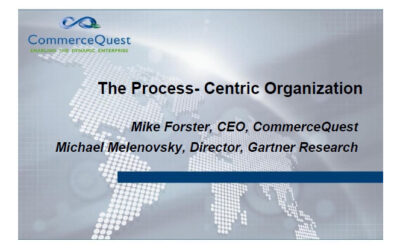Service-Oriented Architecture (SOA) represents a more flexible approach to building IT solutions. Combining SOA with other complementary technologies and approaches further enhances the ability to build more agile solutions. These solutions are easier to change, provide improved access to time-critical information and are more aware of – and responsive to – business events throughout the value chain.
Tom Dwyer
Member since
Jan 01, 2005
Associate Corporate Membership

Business Architecture (BA)
Articles by: Tom Dwyer
Realizing the Strategic Promise of SOA Requires SOA Governance
Recent tactical success in the utilization of Web services has brought renewed attention to the timing for a strategic commitment to Service Oriented Architectures (SOA). Early adopters have been investing in SOA for the past five years but now the development of more rigorous methodologies and technologies, and the maturing of standards, are making SOA accessible to everyone.
Expanding SOA Throughout the Enterprise
How are the business and IT environments changing to meet the challenges of today’s fast-paced global business landscape? They are both striving to become more agile. IT is being focused more on increasing profits, revenues and efficiency than just reducing costs. The business is examining ways to improve customer satisfaction and competitive advantage by collaborating throughout the value chain to deliver more innovative and competitive products and services.
Transforming the Management of Government
Truly transforming the management of government business requires both an architectural and process-oriented approach. This transformation is the strategic goal of the 2001 Presidential Management Agenda (PMA) and is enabled by the Federal Enterprise Architecture (FEA). The Business Reference Model (BRM) is one of five reference models in the FEA and is the first layer of the FEA and it is the main viewpoint for the analysis of data, service components and technology specified in the FEA. It is also the primary reference model that establishes the relationship with BPM.
The Strategic Promise of SOA
How are the business and IT environments changing to meet the challenges of today’s fast-paced global business landscape? They are both striving to become more agile. IT is being focused more on increasing profits, revenues and efficiency than just reducing costs. The business is examining ways to improve customer satisfaction and competitive advantage by collaborating throughout the value chain to deliver more innovative and competitive products and services.
How Strategic is SOA at Your Company?
In an ideal world, companies would run their businesses as if their application portfolio were a single application. This application would take orders, generate shipping notices, and manage accounts receivable. It would also run manufacturing processes, automatically replenish materials as necessary, and exist as a Web-based front-end for customer interaction.
Enabling the Process-Driven Agile Enterprise
What do Business Process Management, Service-Oriented Architecture, Business Architecture, Business Rules and Organizational Performance all have in common? Well, besides the obvious…
BPMInstitute.org and SOAInstitute.org research shows that companies are planning to marshal these technologies and methodologies together into a comprehensive strategy, platform and discipline.
What do Business Process Management, Service-Oriented Architecture, Business Architecture, Business Rules and Organizational Performance all have in common? Well, besides the obvious…
BPMInstitute.org and SOAInstitute.org research shows that companies are planning to marshal these technologies and methodologies together into a comprehensive strategy, platform and discipline. One that will enable organizations to make better business decisions – more quickly – both in the short term and the long term.
What is BPM Anyway? Business Process Management Explained
BPMInstitute.org defines Business Process Management as the definition, improvement and management of a firm’s end-to-end enterprise business processes in order to achieve three outcomes crucial to a performance-based, customer-driven firm: 1) clarity on strategic direction, 2) alignment of the firm’s resources, and 3) increased discipline in daily operations.
BPM is an enterprise-wide, structured approach to providing the products and services that your customer’s value most. It is grounded in the premise that you must take a process view of your company in order to understand what products and services your customer values most. By understanding the key business processes your company uses to meet these customer needs, the gap between customer expectations and your ability to perform begins to emerge.
SOA Demonstrates Broad Momentum
Service-oriented architecture (SOA) is gaining broad momentum throughout business applications that support all aspects of business operations, according to The Yankee Group 2005 U.S. Enterprise SOA Survey (see Figure 1). The survey of 306 IT executives...
SOA Adoption Should Stimulate Demand for BPM, BAM and BRM
In today's environment, business dynamics and technological innovations have left organizations with a disparate mix of operating systems, applications and databases. This makes it difficult, time-consuming and costly for IT departments to deliver new applications...























